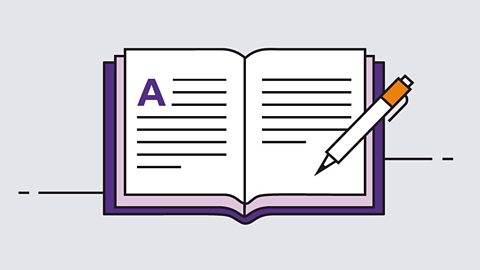How to use suffixes in your writing
- A suffix is a letter or group of letters added to the end of a word to form a new word.
- You might need to add a suffix to change the tense of a word.
- There are some useful patterns and rules that can help you use the right suffix.
Learn the patterns and rules for using suffixes
Using suffixes
Sometimes the root form of a word isn’t enough. You need to add a group of letters to the end of a word to make a new word. For example, if the suffix ‘ing’ is added to the end of the word ‘look’, the new word is ‘looking’ - or the suffix ‘ed’ could be added to make it past tense.
Often, it isn't as simple as adding the suffix - you need to change the ending of the root word in some way.
To understand the suffix patterns, it helps to know the difference between a vowel - a, e, i, o, u - and a consonant - all the other letters in the alphabet.
Doubling the consonant
When a verb - a ‘doing’, ‘having’ or ‘being’ word - ends with a single vowel and a single consonant, usually, you double the consonant before adding the suffix to change tense:
- run can become running
- stop can become stopped
- fog can become foggy
- rot can become rotted
Dropping the ‘e’

The ‘e’ usually gets dropped from the end of a word when a vowel suffix is added. A vowel suffix is a suffix that starts with a vowel, like ‘ing’ and ‘able’:
- write can become writing
- excite can become excitable
- love can become lovable
- adventure can become adventurous
However, there are some words that keep the ‘e’ when a vowel suffix is added. For example, with words ending in ‘ce’ or ‘ge’:
- knowledge can become knowledgeable
- notice can become noticeable
- advantage can become advantageous

Keeping the ‘e’
When you are adding a consonant suffix you usually keep the ‘e’ at the end of the word. A consonant suffix is a suffix that starts with a consonant, like ‘ly’, ‘less’ or ‘ment’:
- definite can become definitely
- late can become lately
- lone can become lonely
- effective can become effectively
- manage can become management
- home can become homeless
There are a few words that don’t follow this rule, for example, the word argument does drop the ‘e’ even though it has a consonant suffix.
Adding ‘ied’

When a word ends with a consonant and a ‘y’ you almost always add an ‘i’ to the ‘ed’ suffix. These words are usually verbs that are being changed into the past tense:
- try can become tried
- hurry can become hurried
- marry can become married
- worry can become worried
- party can become partied

Adding ‘ful’
When you change a noun into an adjective you often add a suffix. A noun is a word to name an object or idea and an adjective describes a noun. For example, sometimes you drop the letter ‘y’ and add an ‘i’ to the suffix ‘ful’:
- beauty can become beautiful
- mercy can become merciful
It’s useful to remember that very few suffixes end in a double ‘l’. For example, the suffix ‘ful’ is spelt with only one ‘l’ and is not spelt ‘full’ - even though the suffix does mean ‘full of’:
- thought can become thoughtful
- care can become careful
- power can become powerful
When the word is turned into an adverb, the suffix does have a double ‘ll’. An adverb gives more information about the verb, an adjective or another adverb:
- power can become powerfully
- general can become generally
Use suffixes in your writing
Use the root word in the brackets and your knowledge of spelling suffixes to identify the correct word and complete these sentences:
Remember
Suffix rules can be confusing and are often explained in slightly different ways. Notice how many times the word ‘usually’ or ‘often’ is used in this explanation. That’s because there are also words that don’t follow the rules. Stay curious about these tricky spellings and look out for patterns in suffix words you use every day.
Quiz
Find out how much you know about using suffixes in this short quiz!
Where next?
Discover more from around Bitesize.
How to spell plural nouns. revision-guideHow to spell plural nouns
KS3 English with media

How to memorise tricky spellings
KS3 English

More on Spelling
Find out more by working through a topic
- count1 of 2

